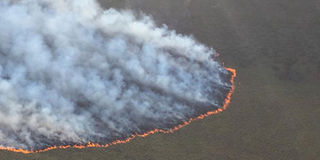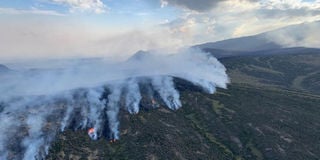Keep intruders out of parks to curb fires: Environment team

The fire at Mt Kenya National Park rages on in this picture supplied by the Kenya Forest Service on March 2, 2019. PHOTO | COURTESY
What you need to know:
- Environment committee chair Kareke Mbiuki has asked the Kenya Forest Service and the Kenya Wildlife Service officers manning forests and national parks to be more vigilant in keeping "criminals" out.
- The chair's remarks followed fires at Mt Kenya and Aberdare national parks, where at least 100,000 and 700 hectares of vegetation, respectively, have been destroyed.
- The parliamentarian asked communities in the areas to work with the KWS and KFS officers in protecting natural resources.
The parliamentary Environment and Natural Resources committee has called for strict measures to keep intruders out of forests as part of efforts to prevent fires.
In a phone interview with the Nation from Cape Town in South Africa on Saturday, chairman Kareke Mbiuki (Maara) asked Kenya Forest and Kenya Wildlife service officers manning forests and national parks to be more vigilant in keeping "criminals" out.
Mr Mbiuki said activities by licensed honey and firewood harvesters must also be minimised in February and September, the driest, to prevent wildfires.
“The committee calls on KFS and KWS officers to be more alert during dry spells," he said.

The fire at Mt Kenya National Park rages on in this picture supplied by the Kenya Forest Service on March 2, 2019. PHOTO | COURTESY
ECOSYSTEMS
The chair's remarks followed fires at Mt Kenya and Aberdare national parks, where at least 100,000 and 700 hectares of vegetation, respectively, have been destroyed.
In the case of the Aberdare fire, Kenya Wildlife Service Chief Warden Bajila Kofa said it was caused by honey gatherers and community activities, with residents burning grass to kill ticks.
While noting this damage and the deaths of many small animals, Mr Mbiuki termed the fires a big threat to the two ecosystems, the country's main water towers. He also noted their effects on food security.
The parliamentarian asked communities in the areas to work with the KWS and KFS officers in protecting natural resources.

The fire at Mt Kenya National Park rages on in this picture supplied by the Kenya Forest Service on March 2, 2019. PHOTO | COURTESY

The fire at Mt Kenya National Park rages on in this picture supplied by the Kenya Forest Service on March 2, 2019. PHOTO | COURTESY
SO FAR
On Friday evening, the fire Mt Kenya fire extended to the bamboo vegetation near Kinondoni Lodge in Tharaka-Nithi County.
The cause of the fire that started near Lake Ellis in Tharaka-Nithi County, and spread to Embu, Kirinyaga, Meru, Laikipia and Nyeri counties, has not been established.
On Friday, 490 Kenya Defence Forces soldiers were deployed to help put out the wildfire, bringing the number of responders to about 610. Responders have been using twigs, hang pumps and five choppers in their attempts to put out the fires.
The park's Senior Warden, Mr Isaac Mugo, said: "We are hoping that with the [help of] KDF officers, we will put out the fire soon, though it is spreading very fast due to strong winds."
Chief Conservator of Forests, Monica Kalenda, said 120 cases of wildfires have been reported nationwide since January and 110,582 hectares of vegetation destroyed, dealing a blow to the revenue stream.
On Thursday, Environment Cabinet Secretary Keriako Tobiko visited the Mt Kenya ecosystem and assessed actions taken following the fires.





